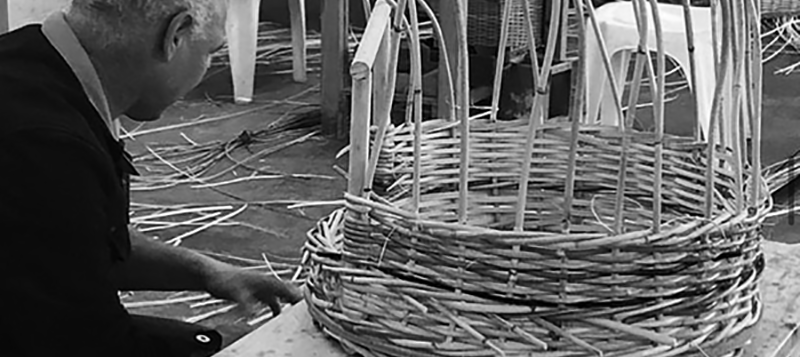THE CAPE WEAVER COLLECTION
Posted by Justin Van Breda on Jan 11th 2021
Founded in 1929 The Cape Town Society for the Blind is a not-for-profit, community based service organisation situated in Salt River in Cape Town and a long standing institution in South Africa. The Cape Weaver Collection presented a great opportunity to work with the charity, supporting a community who strive for independence and autonomy whilst also delivering a truly beautiful, hand-crafted product.
''I wanted to work with the Cape Town Society for the Blind on an exclusive rattan collection because I knew from working with them and visiting their facility how much good we could do for them and also that the craftsmanship of the pieces they make is design driven.'' Justin Van Breda
The interactions with the designers who I wanted to work with to design the handmade and hand finished rattan pieces that would then be crafted by the blind creators all happened quite quickly... It was ‘one a week’ on a mad trip from London via Atlanta to Los Angeles, for Legends of La Cienega, and finally on to New York City. I had lunch with Nina Campbell, the world renowned interior designer and doyenne of British design, who immediately agreed. A week later I bumped into Veere Grenney, the master of British pared down design, standing at a road crossing in Los Angeles and he said yes before the green man lit up!
''I’ve always loved wicker, and also I really believe that the best result of giving to charity is to give the recipients their dignity, not just money. I was intrigued when Justin approached me with his idea of working with The Cape Town Society For The Blind and at the same time produce beautiful and quirky pieces! My dog bed is my favourite of the three pieces and will be particularly useful at home for my two dogs, Theo and Twigs.'' Nina Campbell
For US based designers we asked friends in the industry and were thrilled when Michael Cox, Bill Peace, Joe Lucas and Lauren DeLoach all agreed. I sat next to Amanda Lindroth, the world’s rattan queen, on a flight and so had eight hours to convince her to join the project.
I added international flavour my friend Cynthia Ferguson, a leading Canadian designer (who makes me cry with laughter), joined our gang. I added South African flavour in the instagram sensation Serena Crawford whose posts and stories influence designers and aesthetes all over the world and Mally Skok, a fabulous South African fabric and product designer now based in the US. The link between Mally and Serena and myself is not only one of design, but the mutual love of a peninsula of water that juts out into a bay called Robberg on the coast of South Africa.
''The inspiration for my chair comes from my love of the wonderful natural flora to be found in South Africa. The Cape Province is famous for its incredible botanical biodiversity - my chair reminds me of the softly unfurling of the petals of a protea flower.'' Mally Skok
Of course Nicky Haslam had to be part of it, as he gave me my big break when I moved to London. We decided to recreate the very first cabinet I ever drew up when I worked for him in 1999 which went into the very famous design destination Soniat House, in New Orleans. And so designs began to pour in. From renderings, to design drawings and concept sketches the pieces began to tell a lovely story, one which the craftsman lovingly turned into reality.
o
--------------------------------
Why work with the Cape Town Society for the blind?
Coming from Cape Town myself, I have long been familiar with their pieces. The CTSB have created this amazing community of people who strive for independence and autonomy whilst also producing a truly beautiful, hand-crafted product and I wanted to support their efforts.
Why is Rattan special?
The organic and pliable nature of rattan means it can be formed and molded to create wonderful shapes and patterns and still retain strength. It also has to be made by hand as the pieces are intricate and require attention. Rattan weaving is a craft at risk of dying out and so supporting these communities who are focused on design and education is important.
What is Rattan?
Rattan is the umbrella term for the materials used for weaving across the willow, cane and ivy families. It is not bamboo as bamboo does not bend.
Can I leave my Rattan outside?
Like any natural material from wood to linen, rattan absorbs moisture easily and therefore should not be left out in wet or overly humid climates. All natural materials will expand and contract as temperatures fluctuate, so don't be surprised if your webbing looks a little loose on a particularly wet and dismal day.
Why is Rattan fashionable?
We have seen such a huge increase in sustainability and responsible, considered and informed purchasing. Rattan is both organic and sustainable. It can also echo a sexy seventies vibe or an elegant chic twenties sophistication which is hugely appealing to today’s consumer.
How do blind people weave?
Partially sighted and completely blind people can weave from touch and as its a skill that requires the artists to be stationery they can sit and work by feel and familiarity. It is also a skill they can be taught to work with from home, therefore reducing the need to travel.
O
VIEW THE COLLECTION
Learn more about The Cape Town Society for the Blind
O



